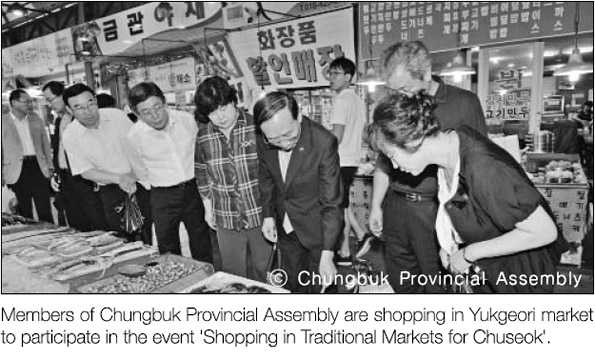
Early this September, ‘Traditional Market Sales Cut in Half’ was in the top spot of the real time search ranking for the day. It said that traditional market sales were halved compared to 12 years ago even though the government has supported them. The annual total sales slipped below ₩30 trillion in 2005 and kept decreasing as years went by. On the other hand, Super SuperMarket(SSM)s sale steadily increased from ₩33.2 trillion in 2009 to ₩45.1 trillion in 2013. More than ₩3.5 trillion of the government’s budget has been invested in revitalizing traditional markets for 12 years, but traditional markets couldn’t compete with SSMs. Finally, it became harder for the government to avoid being criticized for having wasted their budget.
Then, is it proceeding well to revitalize traditional markets in Cheongju? Upon investigation, communication between the city institution and market vendors is not working, and that is reducing efficiency. Recently, Cheongju announced that the project expanding Wi-fi zones in areas where information facilities are lacking would go ahead from this October. Several traditional markets among 57 target areas of the project were included. However, it is uncertain if this project will be effective in revitalizing markets. According to interviews with Cheongju market vendors, most of them negatively said, “The factors which are important in gaining customers are not considered because the city institution decides ahead of time how the budget will be used.”
Additionally, there is an opinion that the government and city institutions are only interested in showing how they perform the revitalizing project. Early in September, Cheongju held an event where city officials and members of civic groups shopped in traditional markets for Chuseok. However, market vendors dismissed that event as a performance business. Mrs. Park, who has run a restaurant for 5 years in Seomun market, said, “If the event was for revitalizing traditional markets, they should have been for alienated and deserted markets, but most of them went to Yukgeori market, where people usually crowd.” For another example, President Park Geun-hye’s visit to traditional markets became hot news this July. She visited Seomun market in Cheongju, and the media reported that the market sales had increased by over 50% because of the president’s visit. However, it was a temporary phenomenon where curious people gathered around for a moment. In practice, the sales of other restaurants, except for a restaurant where the president tasted food, have been decreasing.
Present day traditional markets have many good things. Jeong Eun-jin(’13, School of Business), who often shops in a traditional market, said, “The advantage of traditional markets is that prices are cheaper than in SSMs. Also, I can bargain over the price. It is easy to find almost all goods I need in SSMs, but sometimes prices are too expensive, so I usually shop in the traditional market.” However, the city institutions’ preliminary research about problems of traditional markets is seriously lacking. One of the greatest weaknesses is accessibility. There are several traditional markets which are located in narrow and remote areas in Cheongju. Actually, most market vendors have claimed necessity of parking areas since a few years ago, but there has not been any announced plan about improvement of access. First of all, it seems to be really necessary for the city institution to communicate with market vendors.
By Choi Da-yeong | dy35@cbnu.ac.kr


 All
All Society & Global
Society & Global






 Choi Da-yeong
Choi Da-yeong











